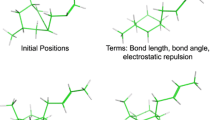Summary
A new computer program is described, which positions small molecules into clefts of protein structures (e.g. an active site of an enzyme) in such a way that hydrogen bonds can be formed with the enzyme and hydrophobic pockets are filled with hydrophobic groups. The program works in three steps. First it calculates interaction sites, which are discrete positions in space suitable to form hydrogen bonds or to fill a hydrophobic pocket. The interaction sites are derived from distributions of nonbonded contacts generated by a search through the Cambridge Structural Database. An alternative route to generate the interaction sites is the use of rules. The second step is the fit of molecular fragments onto the interaction sites. Currently we use a library of 600 fragments for the fitting. The final step in the present program is the connection of some or all of the fitted fragments to a single molecule. This is done by bridge fragments. Applications are presented for the crystal packing of benzoic acid and the enzymes dihydrofolate reductase and trypsin.
Similar content being viewed by others
References
Bernstein, F.C., Koetzle, T.F., Williams, G.J.B., MeyerJr., E.F., Brice, M.D., Rodgers, J.R., Kennard, O., Shimanouchi, T. and Tasumi, T., J. Mol. Biol., 112 (1977) 535.
Cohen, N.C., Blaney, J.M., Humblet, C., Gund, P. and Barry, D.C., J. Med. Chem., 33 (1990) 883.
DesJarlais, R.L., Sheridan, R.P., Seibel, G.L., Dixon, J.S., Kuntz, I.D. and Venkataraghavan, R., J. Med. Chem., 31 (1988) 722.
Lewis, R.A., J. Comput.-Aided Mol. Design, 4 (1990) 205.
Goodford, P.J., J. Med. Chem., 28 (1985) 849.
Tomioka, N., Itai, A. and Iitaka, Y., J. Comput.-Aided Mol. Design, 1 (1987) 197.
Allen, F.H., Kennard, O. and Taylor, R., Acc. Chem. Res., 16 (1983) 146.
Allen, F.H., Bellard, S., Brice, M.D., Cartwright, B.A., Doubleday, A., Higgs, H., Hummelink-Peters, T., Kennard, O., Motherwell, W.D.S., Rodgers, J.R., and Watson, D.G., Acta Crystallogr., B35 (1979) 2331.
Hambley, T.W., Chan, H.K. and Gonda, I., J. Am. Chem. Soc., 108 (1986) 2103.
Crippen, G.M., In Bawden, D. (Ed.) Distance Geometry and Conformational Calculations, Research Studies Press (Wiley), New York, 1981, p. 1.
Rusinko, III, A., Skell, J.M., Balducci, R. and Pearlman, R.S., University of Texas at Austin, distributed by Tripos Ass., 1699 S. Hanley Road, St. Louis, MO 63144, 1987.
Leach, A.R., Prout, K. and Dolata, D.P., J. Comput. Chem., 11, (1990) 680.
Hermann Hesse, Das Glasperlenspiel.
Connolly, M.L., Science, 221, (1983) 709.
Brünger, A.T., Kuriyan, J. and Karplus, M. Science, 235 (1987) 458.
Taylor, R., Kennard, O. and Versichel, W., J. Am. Chem. Soc., 105 (1983) 5761.
Taylor, R., Kennard, O. and Versichel, W., J. Am. Chem. Soc., 106 (1984) 244.
Taylor, R., Kennard, O. and Versichel, W., Acta Crystallogr., B40 (1984) 280.
Burley, S.K. and Petsko, G.A., J. Am. Chem. Soc., 108 (1986) 7995.
Battaglia, M.R., Buckingham, A.D. and Williams, J.H., Chem. Phys. Lett., 78 (1981) 421.
Reid, K.S.C., Lindley, P.F. and Thornton, J.M., FEBS Lett., 190 (1985) 209.
Stoddard, B.L., Bruhnke, J., Porter, N., Ringe, D. and Petsko, G.A., Biochemistry, 29 (1990) 4871.
Murray-Rust, P. and Glusker, J.P., J. Am. Chem. Soc., 106 (1984) 1018.
Böhm, H.J. and Klebe, G., manuscript in preparation.
Kabsch, W., Acta Crystallogr., A32 (1976) 922, A34 (1978) 827.
Ramachandran, G.N., Ramakrishnan, C. and Sasisekharan, V., J. Mol. Biol., 7 (1963) 95.
Dauber-Osguthorpe, P., Roberts, V.A., Osguthorpe, D.J., Wolff, J., Genest, M. and Hagler, A.T., Proteins, 4 (1988) 31.
Bartlett, P.A., Shea, G.T., Telfer, S.J. and Waterman, S., In Roberts, S.M. (Ed.) Molecular Recognition: Chemical and Biological Problems, Royal Society of London, 1989, pp. 182–196.
Bruno, G. and Randaccio, L., Acta Crystallogr., B36 (1980) 1711.
Program SYBYL, distributed by Tripos Ass., 1699 S. Hanley Road, St. Louis, MO 63144.
Bolin, J.T., Filman, D.J., Matthews, D.A., Hamlin, R.C. and Kraut, J., J. Biol. Chem., 257 (1982) 13650.
Program MOLEDT, distributed by BIOSYM Technologies, San Diego, CA 92121.
Marquart, M., Walter, J., Deisenhofer, J., Bode, W. and Huber, R., Acta Crystallogr., B39 (1985) 480.
Baker, B.R. and Erickson, E.H., J. Med. Chem., 10 (1967) 1123.
Stürzebecher, J., Horn, H., Markwardt, F., Wagner, G. and Walsmann, P., Pharmazie 36 (1981) 639.
Bartunik, H.D., Summers, L.J. and Bartsch, H.H., J. Mol. Biol., 210 (1989) 813.
Badger, J., Minor, I., Kremer, M.J., Oliveira, M.O., Smith, T.J., Griffith, J.P., Guerin, D.M.A., Krishnaswamy, S., Luo, M., Rossmann, M.G., McKinlay, M.A., Diana, G.D., Dutko, F.J., Fancher, M., Rueckert, R.R. and Heinz, B.A., Proc. Natl. Acad. Sci. U.S.A., 85 (1988) 3304.
Morgan, B.P., Scholtz, J.M., Ballinger, M.D., Zipkin, I.D. and Bartlett, P.A., J. Am. Chem. Soc., 113 (1991) 297.
Böhm, H.J., to be published.
Author information
Authors and Affiliations
Rights and permissions
About this article
Cite this article
Böhm, HJ. The computer program LUDI: A new method for the de novo design of enzyme inhibitors. J Computer-Aided Mol Des 6, 61–78 (1992). https://doi.org/10.1007/BF00124387
Received:
Accepted:
Issue Date:
DOI: https://doi.org/10.1007/BF00124387




